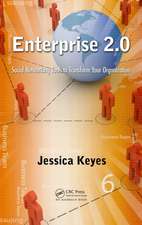Ubiquitous and Pervasive Commerce: New Frontiers for Electronic Business: Computer Communications and Networks
Editat de George Roussosen Limba Engleză Paperback – 16 dec 2005
Din seria Computer Communications and Networks
- 20%
 Preț: 378.19 lei
Preț: 378.19 lei - 20%
 Preț: 684.74 lei
Preț: 684.74 lei - 20%
 Preț: 218.22 lei
Preț: 218.22 lei - 20%
 Preț: 1013.39 lei
Preț: 1013.39 lei - 20%
 Preț: 368.78 lei
Preț: 368.78 lei - 20%
 Preț: 505.49 lei
Preț: 505.49 lei - 20%
 Preț: 646.80 lei
Preț: 646.80 lei - 20%
 Preț: 609.09 lei
Preț: 609.09 lei - 20%
 Preț: 765.60 lei
Preț: 765.60 lei - 20%
 Preț: 339.47 lei
Preț: 339.47 lei - 20%
 Preț: 597.29 lei
Preț: 597.29 lei - 20%
 Preț: 655.85 lei
Preț: 655.85 lei - 20%
 Preț: 997.06 lei
Preț: 997.06 lei - 20%
 Preț: 351.89 lei
Preț: 351.89 lei - 20%
 Preț: 902.04 lei
Preț: 902.04 lei - 20%
 Preț: 996.22 lei
Preț: 996.22 lei - 20%
 Preț: 644.81 lei
Preț: 644.81 lei - 15%
 Preț: 650.69 lei
Preț: 650.69 lei - 20%
 Preț: 650.73 lei
Preț: 650.73 lei - 20%
 Preț: 373.91 lei
Preț: 373.91 lei - 20%
 Preț: 646.95 lei
Preț: 646.95 lei - 20%
 Preț: 1004.99 lei
Preț: 1004.99 lei - 20%
 Preț: 646.80 lei
Preț: 646.80 lei - 20%
 Preț: 341.81 lei
Preț: 341.81 lei - 20%
 Preț: 656.19 lei
Preț: 656.19 lei - 20%
 Preț: 651.75 lei
Preț: 651.75 lei - 20%
 Preț: 331.08 lei
Preț: 331.08 lei - 20%
 Preț: 650.40 lei
Preț: 650.40 lei - 20%
 Preț: 988.66 lei
Preț: 988.66 lei - 20%
 Preț: 643.97 lei
Preț: 643.97 lei - 20%
 Preț: 761.44 lei
Preț: 761.44 lei - 20%
 Preț: 332.71 lei
Preț: 332.71 lei - 20%
 Preț: 345.59 lei
Preț: 345.59 lei - 20%
 Preț: 332.06 lei
Preț: 332.06 lei - 20%
 Preț: 996.22 lei
Preț: 996.22 lei - 20%
 Preț: 644.15 lei
Preț: 644.15 lei - 20%
 Preț: 326.64 lei
Preț: 326.64 lei - 20%
 Preț: 320.19 lei
Preț: 320.19 lei - 20%
 Preț: 1013.06 lei
Preț: 1013.06 lei - 20%
 Preț: 642.52 lei
Preț: 642.52 lei - 20%
 Preț: 641.01 lei
Preț: 641.01 lei - 20%
 Preț: 718.56 lei
Preț: 718.56 lei - 20%
 Preț: 1043.41 lei
Preț: 1043.41 lei
Preț: 635.96 lei
Preț vechi: 748.20 lei
-15% Nou
Puncte Express: 954
Preț estimativ în valută:
121.70€ • 130.13$ • 101.46£
121.70€ • 130.13$ • 101.46£
Carte tipărită la comandă
Livrare economică 17 aprilie-01 mai
Preluare comenzi: 021 569.72.76
Specificații
ISBN-13: 9781846280351
ISBN-10: 1846280354
Pagini: 208
Ilustrații: XIV, 194 p. 34 illus.
Dimensiuni: 155 x 235 x 10 mm
Greutate: 0.3 kg
Ediția:2006
Editura: SPRINGER LONDON
Colecția Springer
Seria Computer Communications and Networks
Locul publicării:London, United Kingdom
ISBN-10: 1846280354
Pagini: 208
Ilustrații: XIV, 194 p. 34 illus.
Dimensiuni: 155 x 235 x 10 mm
Greutate: 0.3 kg
Ediția:2006
Editura: SPRINGER LONDON
Colecția Springer
Seria Computer Communications and Networks
Locul publicării:London, United Kingdom
Public țintă
ResearchCuprins
Ubiquitous Computing for Electronic Business.- Supply Chain Management Standards in Ubiquitous Commerce.- Optimizing Business Processes by Automatic Data Acquisition: RFID Technology and Beyond.- RFID in Movable Asset Management.- Ubiquitous Services: Extending Customer Relationship Management.- The Business Value of Ubiquitous Computing Technologies.- Ubiquitous Computing, Customer Tracking, and Price Discrimination.- The Design of Pervasive Retail Experiences.- Legal Challenges to Ubiquitous Commerce.- Thoughts on Retail System Design to Support Polimorphic Actions Among Clerks: That’ll Be $20 — But if You Buy Two, I’ll Knock off 10%.- Privacy Protection and RFID.
Recenzii
Search
Ubiquitous and pervasive commerce : new frontiers for electronic business
(Computer Communications and Networks)
Roussos G., Springer-Verlag New York, Inc., Secaucus, NJ, 2005. 194 pp. Type: Book
Date Reviewed: Mar 28 2006
Ubiquitous computing (UC) applications can now be found in places other than science
fiction books. As they are intended to be invisible, we need to look for them more carefully.
The emergence of techniques for the ubiquitous and pervasive computing paradigm
signifies a new wave in computing, one where technology loses its imminent visibility and
blends with objects, locations, and even humans. Still in its inception, this movement is
gaining momentum in different application areas. The commerce area, however, appears to
have gone further than others.
This volume presents a methodological overview of the new frontiers for e-business,
discussing its past, present, and possible futures. When we look at e-business historically--
from 1951, when for the first time software was used to conduct business (by J. Lyons and
Co., an example from the first chapter of the book), through the development of bar codes,
to the current implementation of radio frequency identification (RFID) tags placed in
products--we become aware of the amount of work and ideas that have been implemented
or abandoned.
In addition to the introductory part, the book has three other parts: "Technology,”
"Business,” and "Society,” with a total of 11 chapters that complement each other greatly.
The "Technology” part of the book focuses on the supply chain management standards in
ubiquitous commerce and on a couple of applications of RFID technology. The "Business”
part discusses such topics as UC approaches to extending customer relationship
management, customer tracking, price discrimination, and the design of pervasive retail
experiences. The "Society” partfocuses on the legal and societal challenges of the use of
UC in commerce, as it will impose significant changes in the way we do business.
In conclusion, this is an easy-to-read volume that will be of use to casual readers,
students, and researchers.
Reviewer: Goran Trajkovski Review #: CR132598
Distributed
Commercial
Transactions
(K.4.4 ... )
Electronic
Commerce
(K.4.4 )
Electronic Data
Interchange
(EDI) (K.4.4 ... )
Miscellaneous
(K.4.m )
Would you recommend this review? yes no
Other reviews under "Distributed Commercial Transactions": Date
An ER framework for e-contract modeling, enactment and monitoring
Krishna P., Karlapalem K., Chiu D. Data & Knowledge Engineering 51(1): 31-58, 2004. Type:
Article
Feb 10 2005
Understanding customer trust in agent-mediated electronic commerce, Web-mediated electronic
commerce, and traditional commerce
Komiak S., Benbasat I. Information Technology and Management 5(1-2): 181-207, 2004. Type:
Article
Jul 22 2004
Negoisst: a negotiation support system for electronic business-to-business negotiations in ecommerce
Schoop M., Jertila A., List T. Data & Knowledge Engineering 47(3): 371-401, 2003. Type: Article
Jul 2 2004
more...
E-Mail This Printer-Friendly
Reproduction in whole or in part without permission is prohibited. Copyright 2006 Reviews.com™
Terms of Use | Privacy Policy
Ubiquitous and pervasive commerce : new frontiers for electronic business
(Computer Communications and Networks)
Roussos G., Springer-Verlag New York, Inc., Secaucus, NJ, 2005. 194 pp. Type: Book
Date Reviewed: Mar 28 2006
Ubiquitous computing (UC) applications can now be found in places other than science
fiction books. As they are intended to be invisible, we need to look for them more carefully.
The emergence of techniques for the ubiquitous and pervasive computing paradigm
signifies a new wave in computing, one where technology loses its imminent visibility and
blends with objects, locations, and even humans. Still in its inception, this movement is
gaining momentum in different application areas. The commerce area, however, appears to
have gone further than others.
This volume presents a methodological overview of the new frontiers for e-business,
discussing its past, present, and possible futures. When we look at e-business historically--
from 1951, when for the first time software was used to conduct business (by J. Lyons and
Co., an example from the first chapter of the book), through the development of bar codes,
to the current implementation of radio frequency identification (RFID) tags placed in
products--we become aware of the amount of work and ideas that have been implemented
or abandoned.
In addition to the introductory part, the book has three other parts: "Technology,”
"Business,” and "Society,” with a total of 11 chapters that complement each other greatly.
The "Technology” part of the book focuses on the supply chain management standards in
ubiquitous commerce and on a couple of applications of RFID technology. The "Business”
part discusses such topics as UC approaches to extending customer relationship
management, customer tracking, price discrimination, and the design of pervasive retail
experiences. The "Society” partfocuses on the legal and societal challenges of the use of
UC in commerce, as it will impose significant changes in the way we do business.
In conclusion, this is an easy-to-read volume that will be of use to casual readers,
students, and researchers.
Reviewer: Goran Trajkovski Review #: CR132598
Distributed
Commercial
Transactions
(K.4.4 ... )
Electronic
Commerce
(K.4.4 )
Electronic Data
Interchange
(EDI) (K.4.4 ... )
Miscellaneous
(K.4.m )
Would you recommend this review? yes no
Other reviews under "Distributed Commercial Transactions": Date
An ER framework for e-contract modeling, enactment and monitoring
Krishna P., Karlapalem K., Chiu D. Data & Knowledge Engineering 51(1): 31-58, 2004. Type:
Article
Feb 10 2005
Understanding customer trust in agent-mediated electronic commerce, Web-mediated electronic
commerce, and traditional commerce
Komiak S., Benbasat I. Information Technology and Management 5(1-2): 181-207, 2004. Type:
Article
Jul 22 2004
Negoisst: a negotiation support system for electronic business-to-business negotiations in ecommerce
Schoop M., Jertila A., List T. Data & Knowledge Engineering 47(3): 371-401, 2003. Type: Article
Jul 2 2004
more...
E-Mail This Printer-Friendly
Reproduction in whole or in part without permission is prohibited. Copyright 2006 Reviews.com™
Terms of Use | Privacy Policy
Textul de pe ultima copertă
Ubiquitous and pervasive computing will be the emerging computing paradigm for the next few decades. What differentiates it from previous technologies is the fact that computation and wireless communications capability is embedded into objects, locations and even people. Like every new technology before it, ubiquitous and pervasive computing has considerable implications for conducting business. Products, locations, consumers and employees can create rich streams of information about themselves, their immediate environment and their use. This information is fed into the business process to provide unique insights on the current and future situation of the business.
This book brings together the technological and business aspects of conducting commerce using ubiquitous and pervasive computing techniques, and also examines its implications for society at large. Individual chapters review the core technologies that make ubiquitous computing possible, the business standards that must be established to support the envisioned global infrastructures, and the applications that can be built today. They also examine business cases where investment in this technology is appropriate, as well as the economics mechanisms that must be designed for the effective use of such systems. Last but not least, the implications of ubiquitous and pervasive commerce for the legal system, employees and retailers, and the protection of the privacy of the general public are discussed.
This book brings together the technological and business aspects of conducting commerce using ubiquitous and pervasive computing techniques, and also examines its implications for society at large. Individual chapters review the core technologies that make ubiquitous computing possible, the business standards that must be established to support the envisioned global infrastructures, and the applications that can be built today. They also examine business cases where investment in this technology is appropriate, as well as the economics mechanisms that must be designed for the effective use of such systems. Last but not least, the implications of ubiquitous and pervasive commerce for the legal system, employees and retailers, and the protection of the privacy of the general public are discussed.
Caracteristici
First book to survey ubiquitous commerce Adopts a holistic approach with contributions from researchers and practitioners with backgrounds in technology, business, law, economics and interaction design All contributors have hands-on experience with ubiquitous commerce systems Refers to true ubiquitous computing applications rather than re-branding the failed mobile commerce models as ubiquitous Includes supplementary material: sn.pub/extras





